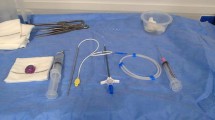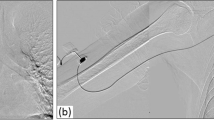Abstract
Background: Chronic indwelling central venous access devices (CICVAD) generally are placed by the percutaneous subclavian vein approach. The cephalic vein cutdown approach is used only infrequently. Although the technique has been well described, few prospective data are available on the cephalic vein cutdown approach.
Methods: From September 9, 1998, to July 20, 1999, the cephalic vein cutdown approach was attempted in 100 consecutive cancer patients taken to the operating room with the intention of placing CICVAD. Median patient age was 54.5 years (range 18–88), with 46 men and 54 women. Twenty-five patients had gastrointestinal malignancies, 17 had breast cancer, 15 had lymphoma, 13 had lung cancer, 12 had leukemia, 5 had multiple myeloma, and 13 had other malignancies. Patients were followed prospectively for immediate and long-term outcome.
Results: CICVAD placement via the cephalic vein cutdown approach was successful in 82 patients; the remaining 18 patients required conversion to a percutaneous subclavian vein approach. The reasons for inability to place CICVAD via cephalic vein cutdown approach were a cephalic vein that was too small (10 patients), an absent cephalic vein (7 patients), and inability to traverse the angle of insertion of the cephalic vein into the subclavian vein (1 patient). There were 56 subcutaneous ports and 26 tunneled catheters. Median operating time was 44 minutes (range, 26–79 minutes). No postoperative pneumothorax occurred. Median catheter duration was 198 days (range, 0–513 days). Long-term complications included catheter-related bacteremia (6%), site infection (2%), deep venous thrombosis (5%), port pocket hematoma (1%), and superior vena cava stricture (1%). Thirty-seven percent of patients have died since CICVAD placement. Twenty-nine percent of the CICVADs have been removed.
Conclusions: The cephalic vein cutdown approach was successful in 82% of patients. This approach is a safe and useful alternative to the percutaneous subclavian vein approach.
Similar content being viewed by others
References
Heimbach DM, Ivy TD. Technique for placement of a permanent home hyperalimentation catheter. Surg Gynecol Obstet 1976;143:634–636.
Hickman RO, Buckner CG, Clift RA, Sanders JE, Stewart P, Thomas ED. A modified right atrial catheter for access to the venous system in marrow transplant recipients. Surg Gynecol Obstet 1979;148:871–875.
Mulieri M, Di Iuri S, Rispoli S. La vena cefalica. La Chirurgia Toracica 1979;1:64–66.
Wade JC, Newman KA, Schimpff SC, VanEcho DA, Gelber RA, Reed WP, Wiernik PH. Two methods for improved venous access in acute leukemia patients. JAMA 1981;246:140–144.
Abrahm JL, Mullen JL. A prospective study of prolonged central venous access in leukemia. JAMA 1982;248:2868–2873.
Dell’Amore D, Gardini G. Use of the cephalic vein for placement of central venous catheter. Ital J Surg Sciences 1982;12:139–142.
Davis SJ, Thompson JS, Edney JA. Insertion of Hickman catheters. A comparison of cutdown and percutaneous techniques. Am Surg 1984;50:673–676.
Chuter T, Starker PM. Placement of Hickman-Broviac catheters in the cephalic vein. Surg Gynecol Obstet 166;1988:163–164.
Coit DG, Turnbull ADM. A safe technique for the placement of implantable vascular access devices in patients with thrombocytopenia. Surg Gynecol Obstet 1988;167:429–431.
Thomas PRS, Sinnett HD. An evaluation of prolonged venous access catheters in patients with leukaemias and other malignancies. Eur J Surg Oncol 1988;14:63–68.
Au FC. The anatomy of the cephalic vein. Am Surg 1989;55:638–639.
Perry EP, Nash JR, Klidjian AM. Direct cephalic vein cannulation for safe subclavian access. J R Coll Surg Edinb 1990;35:218–220.
Henriques HF, Karmy-Jones R, Knoll SM, Copes WS, Giordano JM. Avoiding complications of long-term venous access. Am Surg 1993;59:555–558.
Torramadé JR, Cienfuegos JA, Hernández J-L, Pardo F, Benito C, González J, Balén E, de Villa V. The complications of central venous access systems: a study of 218 patients. Eur J Surg 1993;159:323–327.
Gallichio MH, Kahn D, Lempert N, Conti DJ. Placement of a double lumen Silastic catheter for hemodialysis access through the cephalic vein. J Am Coll Surg 1994;178:171–172.
Sweed M, Guenter P, Lucente K, Turner JL, Weingarten MS. Long-term central venous catheters in patients with acquired immunodeficiency syndrome. Am J Infect Control 1995;23:194–199.
D’Angelo FA, Ramacciato G, Aurello P, Lauro S, Caramitti A, Lalle M, Magri M. Alternative insertion sites for permanent central venous access devices. Eur J Surg Oncol 1997;23:547–549.
Di Giorgio A, Bangrazi C, Canavese A, Arnone P, Barberio-Corsetti F, Pallotti M, AlMansour M. Sistemi totalmente impiantabili in oncologia: la vena cefalica come via d’accesso di elezione. Ann Ital Chir 1997;68:529–536.
Le Saout J, Vallee B, Person H, Doutriaux M, Blanc J, Huu N. Bases anatomiques de l’utilisation chirurgicale de la veine céphalique (V. Cephalica). J Chir (Paris) 1983;120:131–134.
Ross MN, Haase GM, Poole MA, Burrington JD, Odem LF. Comparison of totally implanted reservoirs with external catheters as venous access devices in pediatric oncology patients. Surg Gynecol Obstet 1988;167:141–144.
Ingram J, Weitzman S, Greenberg ML, Parkin P, Filler R. Complications of indwelling venous access lines in the pediatric hematology patient: A prospective comparison of external catheters and subcutaneous ports. Am J Pediatr Hematol Oncol 1991;13:130–136.
Groeger JS, Lucas AB, Thaler HT, Friedlander-Klar H, Brown AE, Kiehn TE, Armstrong D. Infectious morbidity associated with long-term use of venous devices in patients with cancer. Ann Intern Med 1993;119:1168–1174.
Whitman ED. Complications associated with the use of central venous access devices. Curr Probl Surg 1996;33:309–378.
Nightingale CE, Norman A, Cunningham D, Young J, Webb A, Filshie J. A prospective analysis of 949 long-term central venous access catheters for ambulatory chemotherapy in patients with gastrointestinal malignancy. Eur J Cancer 1997;33:398–403.
Author information
Authors and Affiliations
Corresponding author
Rights and permissions
About this article
Cite this article
Povoski, S.P. A Prospective Analysis of the Cephalic Vein Cutdown Approach for Chronic Indwelling Central Venous Access in 100 Consecutive Cancer Patients. Ann Surg Oncol 7, 496–502 (2000). https://doi.org/10.1007/s10434-000-0496-9
Received:
Accepted:
Issue Date:
DOI: https://doi.org/10.1007/s10434-000-0496-9




